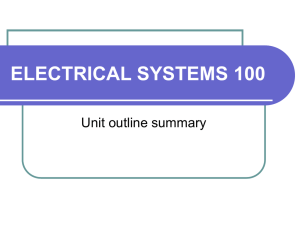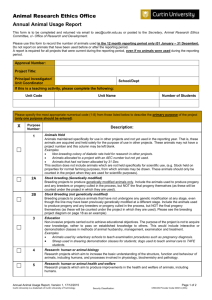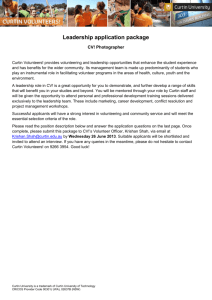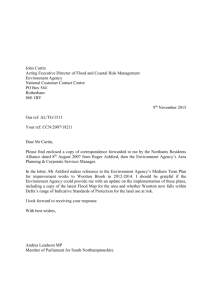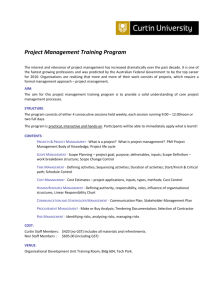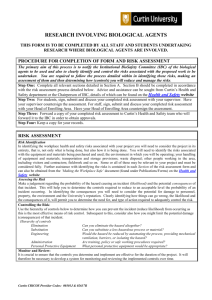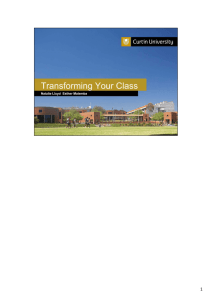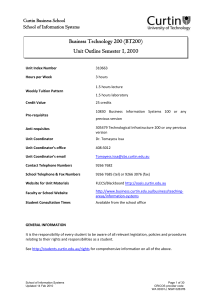outline_sem1_ 2009
advertisement
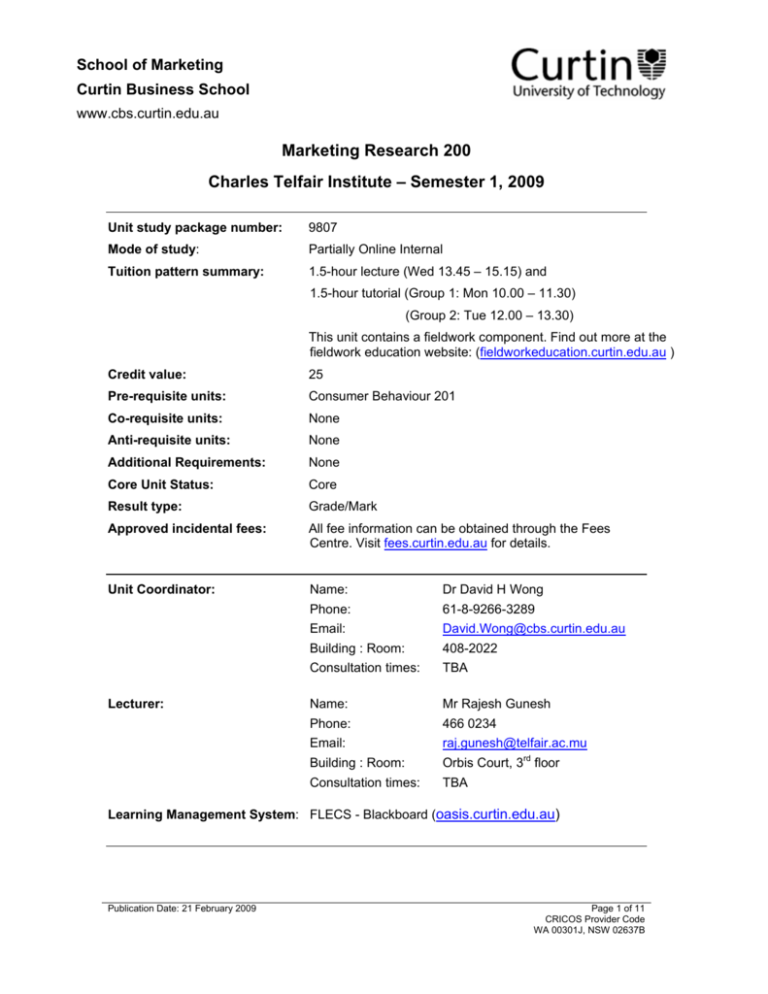
School of Marketing Curtin Business School www.cbs.curtin.edu.au Marketing Research 200 Charles Telfair Institute – Semester 1, 2009 Unit study package number: 9807 Mode of study: Partially Online Internal Tuition pattern summary: 1.5-hour lecture (Wed 13.45 – 15.15) and 1.5-hour tutorial (Group 1: Mon 10.00 – 11.30) (Group 2: Tue 12.00 – 13.30) This unit contains a fieldwork component. Find out more at the fieldwork education website: (fieldworkeducation.curtin.edu.au ) Credit value: 25 Pre-requisite units: Consumer Behaviour 201 Co-requisite units: None Anti-requisite units: None Additional Requirements: None Core Unit Status: Core Result type: Grade/Mark Approved incidental fees: All fee information can be obtained through the Fees Centre. Visit fees.curtin.edu.au for details. Unit Coordinator: Name: Dr David H Wong Phone: 61-8-9266-3289 Email: David.Wong@cbs.curtin.edu.au Building : Room: 408-2022 Consultation times: TBA Name: Mr Rajesh Gunesh Phone: 466 0234 Lecturer: Email: raj.gunesh@telfair.ac.mu Building : Room: Orbis Court, 3rd floor Consultation times: TBA Learning Management System: FLECS - Blackboard (oasis.curtin.edu.au) Publication Date: 21 February 2009 Page 1 of 11 CRICOS Provider Code WA 00301J, NSW 02637B Syllabus Introduction to the scientific method and technology of marketing research, the application of market research data to resource key marketing and strategic decisions, and the professional skills of winning and serving a research client. A hands-on market research project for a real business client consolidates the ideas and skills gained. Introduction Marketing research is usually perceived to be a difficult and boring subject. It does not have to be! As long as you have the positive mindset, it can be as dynamic, motivating, selfsatisfying and mostly fun as any other favourite subject of yours. Undoubtedly, it is an important tool in marketing management. By understanding the research process, the researcher will be in a better position to assess the suitability, reliability and validity of a research study. As such, a good grasp of the commonly used tools in marketing research is imperative. Unit Learning Outcomes On successful completion of this unit you will be able to: 1. Employ the scientific approach to carrying out marketing research, including the use of exploratory and descriptive research techniques 2. Explain the possible errors in survey research and the techniques available to minimise these errors 3. Design a survey instrument (e.g. a questionnaire) that will be used to collect relevant information from target respondents 4. Design a sampling strategy for the collection of data, and apply fieldwork techniques in interacting with the surveyed respondents 5. Understand the different types of statistical tools available and apply these tools to analyze different types of collected data 6. Develop a presentation of your research findings to management for decision making Learning Activities Lectures The purpose of the lecture is to describe some of the principles in the unit and the application of those principles. A lecture does not cover all there is to learn about the area. You will need to read and study further those areas covered in the lecture. Similarly, it is not possible to cover in the lecture all the unit material contained in the prescribed text. However, all material in the prescribed text, whether covered in the lecture or not, forms the subject matter of discussion in the tutorials and may be examinable in the tests and the final examination. Tutorials The purpose of the tutorial is to provide a small group forum for learning and applying decision making, and written and oral communication skills; assess your knowledge and skills; provide an opportunity for you to raise questions with your tutor about the course (e.g. difficulties experienced with textbooks, or with tutorial tasks). You should attend one tutorial per week, commencing in the first week of the semester. Your tutor will keep a record of your tutorial attendance. Publication Date: 21 February 2009 Page 2 of 11 CRICOS Provider Code WA 00301J, NSW 02637B The tutorials will be largely project based. Your tutor will guide you through your project on a step-by-step basis. It is important to attend tutorials in order to keep abreast with how the lecture material will be specifically applied to your project. Refer to http://www.cbs.curtin.edu.au/current/classlisting.cfm for the current timetable. Do not change tutorials without the consent of the unit controller and your tutor. Learning Resources Essential Texts You will need to purchase the following textbook in order to complete this unit: Zikmund, William, Ward, Steven, Lowe, Ben and Winzar, Hume (2007) Marketing Research Asia Pacific Edition, 1st Edition, Thomson Learning, Melbourne, Australia, ISBN: 0 17 012734 6. Recommended Texts You do not have to purchase the following textbooks but you may like to refer to them. Coakes, Sheridan J. and Steed, Lyndall G. (2003) SPSS 11 - Analysis without Anguish, John Wiley and Sons Australia Ltd (or Later Versions) Online Resources Wong, David H. (2003) Dave’s Crash Course in Statistics using SPSS GECKO GECKO is your gateway to library databases. This is where you are able to search for secondary data, E-journals and other reference material needed to support your work in both the assignment and project. Access GECKO by following the prompts from http://library.curtin.edu.au/. Suggested resources under the GECKO platform include ABI-Inform, and ProQuest 5000 -All Collections. Assessment Schedule Task Secondary Data Research Assignment (Individual) (Ch 1-5) Final Examination (Individual) (Ch 8,9,10,11 + SPSS Crash Course) Research Project (Group) Research Project Presentation (Group) Value (%) Date due Unit Learning Outcome(s) assessed 20% 3 April 2009 5pm 1, 2 40% University’s Exam Period – Details TBA 29 May 2009 5pm Presentation: Week 11 Tutorial Time 3, 4, 5 35% 5% 1, 2, 3, 4, 5, 6 6 Detailed information on assessment tasks Final Examination The paper consists of two sections. Section A consists of 30 “Fill in the blank” questions. Section B consists of 3 structured questions (with a number of parts). You have to answer all questions. You have 2 hours to complete the exam. Publication Date: 21 February 2009 Page 3 of 11 CRICOS Provider Code WA 00301J, NSW 02637B Secondary Data Research Assignment THE ASSIGNMENT WILL BE AVAILABLE ON BLACKBOARD AT THE START OF THE SEMESTER. Research Project Each group should comprise of 2-5 members. There must NOT be more than 5 members per group. This component of the unit is designed to provide you with some experience in applying the concepts and methods of marketing research to a real marketing research problem. Important Notes: • A two-page project brief (the “Project Approval Form” attached to this unit outline) has to be submitted to your tutor for approval by Week 3. • The final copy of the questionnaire has to be submitted to your tutor for approval before data collection can commence. • FAILURE TO OBTAIN THESE APPROVALS WILL RESULT IN ZERO MARKS FOR THE PROJECT. Project Brief No marks will be given to the project brief. The main idea of the project brief is to ensure that you are on the right track. It is also expected that there may be incremental revisions to the original proposal as the research progresses. The project brief (i.e. “Project Approval Form”) is attached to this unit outline. Statistical Tools The statistical tools must also involve a certain degree of rigour. There should be a good spread of the use of T tests, Chi Square tests, Cross Tabulations, Correlations and if necessary, ANOVA, Factor Analysis and/or Simple Regression. The exclusive use of descriptive statistics is not adequate to obtain a pass grade. Hence, make sure that the design of the questionnaire allows you to apply these techniques. Fair assessment through moderation Moderation describes a quality assurance process to ensure that assessments are appropriate to the learning outcomes, and that student work is consistently evaluated by assessors. Minimum standards for the moderation of assessment are described in the Assessment Manual, available from policies.curtin.edu.au/policies/teachingandlearning.cfm Late penalties There will be a late penalty of 10% off per day or part thereof for all assessments. Pass requirements Students must pass the final exam with a minimum of 50%, and pass overall with a minimum of 50% for the unit. Referencing style Students should use the Chicago referencing style when preparing assignments. More information can be found on this style from the Library web site: library.curtin.edu.au/research_and_information_skills/referencing Publication Date: 21 February 2009 Page 4 of 11 CRICOS Provider Code WA 00301J, NSW 02637B Supplementary information Enrolment and HECS: It is your responsibility to ensure that your enrolment is correct - you can check your enrolment through the eStudent option on OASIS, where you can also print an Enrolment Advice. Supplementary/Deferred Exams: Supplementary and deferred examinations granted by the University will be held periodically. Notification to students will be made after the relevant Board of Examiners meeting via the Official Communications Channel (OCC) in OASIS. It is the student’s responsibility to check their OASIS account for official Curtin correspondence on a weekly basis. If your results show that you have been awarded a supplementary or deferred exam you should immediately check your OASIS email for details. Note: The Curtin Business School does not award supplementary examinations in postgraduate units. Plagiarism Plagiarism occurs when work or property of another person is presented as one's own, without appropriate acknowledgement or referencing. Plagiarism is a serious offence. For more information refer to academicintegrity.curtin.edu.au Plagiarism Monitoring Some (or all) assessments in this unit may be monitored for plagiarism using Turnitin (see turnitin.com). Students who do not want assignments retained in the Turnitin database must lodge a special request prior to the submission date. For further advice see academicintegrity.curtin.edu.au/studentsturnitin.html Student Rights and Responsibilities It is the responsibility of every student to be aware of all relevant legislation, policies and procedures relating to their rights and responsibilities as a student. These include: • • • • • • • • • • the Student Charter, the University’s Guiding Ethical Principles, the University’s policy and statements on plagiarism and academic integrity, copyright principles and responsibilities, the University’s policies on appropriate use of software and computer facilities, students’ responsibility to check enrolment, deadlines, appeals, and grievance resolution, student feedback, other policies and procedures, electronic communication with students See students.curtin.edu.au/rights for comprehensive information on all of the above. Recent unit changes We welcome feedback as one way to keep improving this unit. Students are encouraged to give unit feedback through eVALUate, Curtin’s online student feedback system (see evaluate.curtin.edu.au ). Recent changes to this unit include: 1. Improved online resources 2. Improved assessment structure Publication Date: 21 February 2009 Page 5 of 11 CRICOS Provider Code WA 00301J, NSW 02637B Program calendar Week 1 2 3 4 5 6 7 8 9 10 11 12 Topic Introduction and the Research Process (Project Groupings formed during Tutorials) Problem definition (Project Structure Run-down during Tutorials) Exploratory Research, Qualitative and Secondary Data (Informal Presentations and Submission of Research Proposals during Tutorials (No marks)) Survey Research (Informal Presentations of Secondary and Exploratory Research Findings during Tutorials (No marks)) Measurement Concepts Questionnaire Design (Final Questionnaire to be Pre-tested and Presented to Tutor for Checking during Tutorials) (Individual Assignments Due End of this Week) Sampling Designs (Final Questionnaire Submitted to Tutor for Formal Approval) Fieldwork, Coding and Editing (Data Collection to be Commenced by this Week) Data Analysis Techniques The Research Report / Exam Tips (Formal Presentations during Tutorials (5%)) (Group Project Reports Due End of this Week) Chapter 1 2 3,4 5 8 9 10 11 12,13,14,15 16 Note: Final Exam during the University’s Exam Period – details TBA. Publication Date: 21 February 2009 Page 6 of 11 CRICOS Provider Code WA 00301J, NSW 02637B Appendix 1 Structure and Content of Group Project Final Report Reports should include executive summary, a contents page, and a set of recommendations. An Executive Summary encompasses all the major issues within the report. In business many readers will not read beyond the Executive Summary, hence this component must be written carefully to ensure it embodies the intent of the report. Some useful sites for writing different types of reports are as follows: • • http://startup.curtin.edu.au/study_skills/report.html - Curtin’s Study Skills Report Writing guide site. This is a comprehensive and user-friendly guide. http://www.arbld.unimelb.edu.au/students/essay/essaytech.html - The University of Melbourne Essay and Report Writing Guide In addition, the final report should include but not be limited to the following: 1. Research Focus: Define the research problem explicitly. Some issues include: a. What is the background of the problem? (Provide information such as industry background here). b. Have there been past research (secondary data) already done that could help provide some insights into the problem? c. What is the main purpose served by your current research? Spell out all the research objectives you want to achieve. d. What are the major contributions of the research project? To whom will this research be useful? In what way? 2. Research Methodology: Provide justifications for the chosen design relative to the other alternatives. Provide a detailed description of how the entire process was carried out. This includes the techniques used in exploratory research, its findings, and how it helped you design your research instrument. 3. Research Instrument: Provide a detailed description of the scales used. Are they original or adapted from other printed sources? Describe the pretest and how it led to the questionnaire changes. Attached the final version of the questionnaire as it was presented to the respondent in the Appendix. 4. Sampling: Include a description of population size, sampling frame, type of sample and why they are chosen. Include any limitations that have been compromised. The usable sample should be no less than 200. Therefore, it is advised to plan a larger sample size for such contingencies. Report how many were collected, how many usable and why some were discarded. 5. Results and Analysis: Present and describe your results clearly with tables and charts. Some of the analytical tools you could use are descriptive statistics (eg. frequencies or means of selected variables), and inferential statistics (eg. Cross Tabulations/Chi Square tests, T tests, ANOVA, Correlations, Factor Analysis and/or Regression Analysis). These tests should be followed by a detailed analysis that is guided by your research objectives. In other words, have your findings answered your research questions? It is also useful to include a summary table at the end of this section that restates your research objectives, the tests used to address each objective and a summary of your analysis/findings. 6. Conclusion: Indicate how the results of the research can be used. It should provide decision-making implications, strategic considerations and other managerial or practical recommendations. Also discuss the main strengths and weaknesses of the project. Provide a list of future research objectives for those that were not covered in this project or issues that were uncovered in the duration of this exercise. Publication Date: 21 February 2009 Page 7 of 11 CRICOS Provider Code WA 00301J, NSW 02637B Appendix 2 Conflict Resolution Processes for Group Projects In the event of a conflict within groups, students must undertake the following process prior to presenting their concerns to the Unit Controller: • • • • • • Students must address issues early (do not leave the problem until the week before the project is due) Call a meeting with all group members to discuss a concern or a breach of agreement If resolution is not achieved, request mediation by another student within the class If resolution is not achieved, request mediation by the tutor If resolution is not achieved, present the concern to the Unit Controller Students may be requested to individually complete a “Peer Review Evaluation Form” which is available from FLECS - Blackboard. This may be used as a basis for a redistribution of marks in favour of the better performing students in the group. Appendix 3 Guidelines for Student Presentations Do: • • • • • • • • • • Keep things simple – pitch it to an appropriate level for your audience. Include a clear and motivating introduction – outline the structure of your talk. Ensure your presentation has a logical sequence. Ensure that your talk and visual resources are well organised. Ensure slides/ppt are brief and legible (min. font size 18pt). Check equipment. Include some audience interaction (if possible – increases interest) Rehearse your talk at least 2 or 3 times. It will go much more smoothly if you do. Check your timing and be prepared to edit. Get feedback on distracting mannerisms and attempt to overcome these. Engage your audience - make eye contact with everyone in the audience. Speak clearly and not too quickly. Ensure your conclusion is brief and outlines your main argument/case. Anticipate and prepare for likely questions. Relax and practice your breathing (take 3 deep breaths to commence). Do not: • • • • Read long parts of your slides - this is boring for the audience. Panic if you lose your place or go blank. Pause and appeal to the audience while you regain your composure and then continue. Look at your slides or notes instead of the audience. Do not use jargon or acronyms without explanation – this alienates the audience. Publication Date: 21 February 2009 Page 8 of 11 CRICOS Provider Code WA 00301J, NSW 02637B Appendix 4 MARKETING RESEARCH 200 PROJECT APPROVAL FORM NO GROUP MEMBERS STUDENT NUMBER 1. 2. 3. 4. 5. TITLE RESEARCH FOCUS - BRIEF DESCRIPTION OF THE PROJECT (You will need to show some references to support where you obtained this background information) Publication Date: 21 February 2009 Page 9 of 11 CRICOS Provider Code WA 00301J, NSW 02637B RESEARCH OBJECTIVES (Refer to the text/lecture notes on how to write research objectives - an example of a research objective may be “To determine the relative importance of car attributes people consider when buying a car”.) PROPOSED METHODOLOGY (Keep this very brief – you will build on this as the course progresses) POTENTIAL MANAGERIAL AND/OR PRACTICAL CONTRIBUTIONS (i.e. To whom will this research be useful? In what way?) Publication Date: 21 February 2009 Page 10 of 11 CRICOS Provider Code WA 00301J, NSW 02637B Appendix 5 MARKETING RESEARCH 200 PROJECT MARKING GUIDE Students’ Names: ___________________________________ St. No.: _______________ ___________________________________ St. No.: _______________ ___________________________________ St. No.: _______________ ___________________________________ St. No.: _______________ ___________________________________ St. No.: _______________ Content (Please refer to the unit outline for indepth explanations of the requirements of each Marks Executive Summary 5 Research Focus 10 Research Methodology 15 Research Instrument 5 Sampling 5 Results and Analysis 30 Conclusion & Recommendations 10 Appropriate Use of References / Reference Technique 5 Score Consistency between Objectives, Conceptual Diagram, 10 Questionnaire, and Analysis Clear Report Structure and Clarity of Communication 5 Total 100 Other Comments: _________________________________________________________ _________________________________________________________ Signature/Date: _________________________________________________________ Publication Date: 21 February 2009 Page 11 of 11 CRICOS Provider Code WA 00301J, NSW 02637B
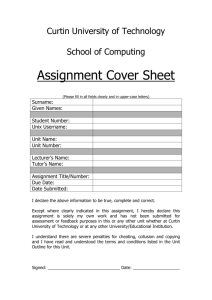
![Assignment coversheet (single) [ 48KB]](http://s3.studylib.net/store/data/008375796_1-47bef2c2c4eb4b7696d1fc3a80518558-300x300.png)
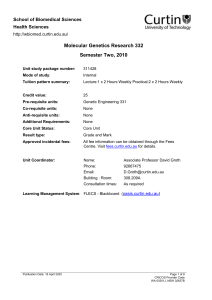
![Assignment coversheet (group) [ 126KB]](http://s3.studylib.net/store/data/008375797_1-0b6687da490940610c4ecb23456dda46-300x300.png)
